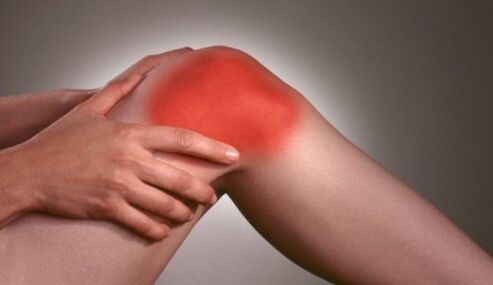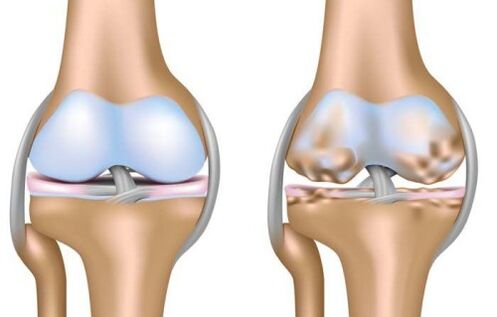Osteoarthritis of the knee (gonarthrosis) is a degenerative disease of the knee joint cartilage. This disease is very common, especially among the older generation. The work of the knee becomes worse, and therefore difficulties in movement and sensation of pain are the most important signs of the disease. Today, knee osteoarthritis is also common in people 25-30 years old. What speaks to the versatility of the causes of the disease and accordingly the treatment. >There are two types of gonarthrosis: unilateral (affecting only one knee) and bilateral (affecting both knees). More often, the disease occurs in bilateral manifestations.

The reasons
Gonarthrosis, like coxarthrosis, usually manifests in old age. Although today there is no exception and the fact that young people have symptoms of this disease. This suggests that the causes of gonarthrosis are different and that each can influence the occurrence, exacerbation, and treatment of the disease in its own way. There are also possibilities of an organism's genetic predisposition, ie. Knee osteoarthritis may be more common in some families than others. In addition, the disease may not be genetically determined. Therefore, there are several causes of gonarthrosis.
- Various physical injuries of the knee (bruises, dislocations, etc. ).
- Large loads do not correspond to age (5-7% of all cases of gonarthrosis, as well as coxarthrosis).
- The patient's body weight is excessive (10% of all cases of gonarthrosis).
- Comorbidities, for example, arthritis (5-7% of all cases of gonarthrosis, polyarthrosis and coxarthrosis).
- Congenital weakness of the ligaments (3-5% of cases with foreskin stenosis).
- Metabolic syndrome and metabolic problems in the body.
- Spasms of the muscles of the upper thigh (up to 50% of cases with gonarthrosis and coxarthrosis).

Symptom
The symptoms of knee osteoarthritis are similar and present in almost all patients. Patients also note that the pain of exudation falls in the spring and autumn period and depends on weather changes. The main symptom of the disease is knee pain. Usually, it does not appear immediately, but is easily noticeable after a long time and appears in the late afternoon. The creaking noise can cause the knee to become stiff with movement. If minor symptoms are not taken care of, the disease can flare up and bring extremely undesirable results to the patient. Despite the main symptoms, there are several other signs of the disease:
- pain syndrome at rest, decrease in quality when walking;
- limited movement of the knee joint and difficulty controlling its mobility;
- stiff knees;
- increased sensitivity in the knee area;
- swelling of the knee joint and swelling of the surrounding skin;
- knee deformity.
Evaluation of the condition of the knee joint is done when the doctor examines and takes X-rays. Furthermore, the disease stage of any joint disease (including coxarthrosis, gonarthrosis, polyarthrosis and others) can only be determined if an X-ray is available and only a physician can assess the condition. that status. Therefore, it is extremely important not to engage in self-diagnosis and not jump to conclusions.
Degree of gonarthrosis
Degree 1
The knee joints cannot withstand the deforming effects of the disease, but only appear by external signs and the skin around the joint is slightly swollen, the color changes are noticeable. At the physiological level, it is characterized by small changes in the hyalinized cartilage. Due to the accumulation of a significant amount of joint fluid in the synovial fluid, minor joint deformities occur, accompanied by pain when walking. Other signs such as limited mobility were not observed. And so it is also very difficult to track them on radiographs. At this level, the disease is difficult to diagnose, but with a quick definition, treatment is more effective than with gonarthrosis of the third degree, as well as other types of joint diseases (coxarthrosis, polyarthrosis).
Degree II
The main symptom is unbearable or severe pain that, even under light loads, is aggravated by walking and lifting weights. Over time, this will develop into difficulty bending the knee. At the physiological level, this is manifested by a sharp decrease in the volume of the cartilage layer, where it is completely absent. According to x-ray results, this extent can be determined by the growth of the marginal bone and the density of the joint cavity. In the work of the joints, especially during long walks, a characteristic crackle appears. Over time, the patient may lose the ability to bend the knee, or it will be very difficult. The disfiguring effect was manifested at this stage of the development of gonarthrosis, as well as other types of rheumatic diseases (coxarthrosis, polyarthrosis). To the naked eye, this is noticeable, and the surrounding skin becomes rough and changes color. Treatment at this stage is better to start complex and intensive. Here, both drugs and traditional treatments will be involved.

Grade III
It is characterized by severe pain, even when the knee joint is inactive or immobile. The deformation effect is very noticeable and one can visually identify significant changes in the structure of the joint and adjacent tissues. At the physiological level, it is marked by the absence of cartilage tissue and this is easily diagnosed on radiographs. Treatment of grade III of osteoarthritis of the knee and other types of joint disease (multiple sclerosis, coxarthrosis) is truly an irreversible process. Instead, the primary goal of such treatment would be to relieve pain and eliminate some of the presenting symptoms of the disease.

























